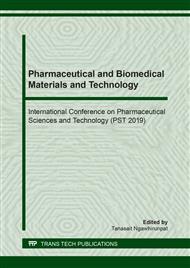p.9
p.15
p.21
p.27
p.33
p.38
p.45
p.51
p.57
Fabrication of Enteric Release Tablet without Coating Process by Using Bleached Shellac
Abstract:
The purpose of this study was to design an enteric release tablet by a simple method of tableting and avoiding the coating process. Polymers which had a protection ability against acid were required for tablet formulation. Bleached shellac was selected as an excipient due to colorless property, a protection ability against acid in upper gastrointestinal tract and release ability in lower gastrointestinal tract. Bleached shellacs in salt and acid forms were dissolved in 12 ml of 95% ethanol and used as a binding agent to get a concentration of 5, 7.5, 10, 12.5, 15, 17.5 and 20 %w/w of total formulation. 60% lactose, 30% Avicel pH 102 and 10% paracetamol (model drug) were mixed and tablets were prepared by wet granulation method with the weight of 550 mg and hardness of 8-10 kg. The tablets were evaluated for their disintegration and drug release at pH 1.2 and 6.8 and kept at 40 °C, 75%RH for 6 months. The findings showed that the disintegration and amount of release were dependent on type and concentration of bleached shellac. Only the bleached shellac in salt form could protect the release of drug at pH 1.2 for 2 h and could release completely at pH 6.8 but not in acid form. After 6 months of storage, 15% bleached shellac in salt form could still protect against acid and complete release at pH 6.8 for 4 h. Although the bleached shellac showed protection ability against acid, it could not comply with the required criteria of enteric release tablet. Further study is hence required. However, the stability test of tablets prepared with bleached shellacs in salt form could show protection against acid and complete release at pH 6.8 after 6 months of storage. Bleached shellacs in salt form as a binding agent showed a good approach for the fabrication of enteric release tablets without coating process by using a proper concentration of bleached shellac. Therefore, the attempt to design an enteric tablet by a simple method and avoiding the coating process is achieved.
Info:
Periodical:
Pages:
33-37
Citation:
Online since:
August 2019
Authors:
Price:
Сopyright:
© 2019 Trans Tech Publications Ltd. All Rights Reserved
Share:
Citation:


